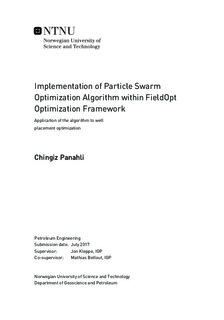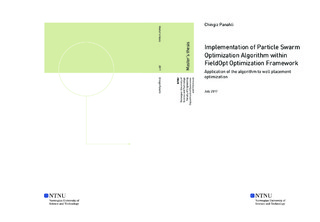| dc.description.abstract | In the present work, particle swarm optimization algorithm is applied in well placement
optimization problem using FieldOpt, a software framework that aims at being common
platform for field development optimization. Different types of particle swarm optimization algorithm have been developed and integrated inside FieldOpt optimization framework in order to increase the capabilities of the framework for field development optimization problems. The algorithm that has been implemented in this work is simple and flexible and it can be used easily as hybrid with other algorithms in the future. We have applied particle swarm optimization algorithm to optimize the locations of vertical and horizontal wells in simple and realistic reservoir models. A dynamic penalty function was coupled inside the algorithm in order to treat the non-linear constraints, such as well length, inter-well distance and reservoir boundary constraints.
We first apply the algorithm on a simple two dimensional five spot model that consists of four vertical injectors and one horizontal producer. We run particle swarm optimization in order to check the performance of the algorithm and determine optimal parameters by performing a sensitivity analysis. Three cases are run on the simple model and the cases vary in terms of the type of constraints implemented. In all the cases, we use fixed control parameters for injectors and producers. In the first case, we optimize the location of one production well that is subject to the well length constraint only. In the second case, we use both well length and reservoir boundary constraints. In the third case, we use all the constraints in order to optimize the location of two horizontal producers. The results suggest that the algorithm converged to an optimum solution with given constraints and assumptions for the simple five spot model.
After getting satisfactory results on the simple reservoir model, we apply particle swarm optimization on a new benchmark known as OLYMPUS. This is a new field development
challenge that is launched by TNO (Netherlands Organization for Applied Scientific Re-
search) within the context of the ISAPP (International Scientific Association for Probiotics and Prebiotics) research program. The reservoir model is characterized with faults, horizontal barriers across the different zones and high permeability channels, which makes the optimization problem more complex than the simple five spot model. The reference operating strategy of the field consists of six injectors and eight producers that are controlled by a pressure constraint. We optimize the locations of first five production wells, while fixing the locations and operating parameters of the other wells as same as in the reference case. Because of high computational demand and time limitations, we could not use enough simulations to reach an optimum solution in this case. However, we compare the optimization runs and give suggestions for future work for the well placement part of the OLYMPUS field development plan. | |

